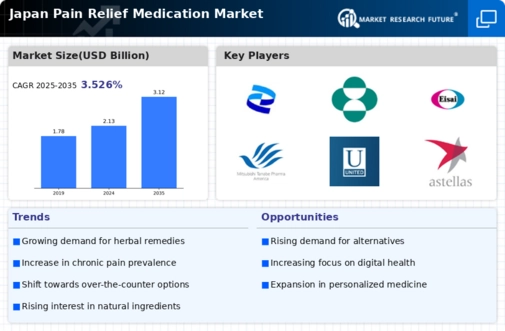Rising Awareness of Pain Management Options
There is a notable increase in awareness regarding pain management options among the Japanese population. Educational campaigns and healthcare initiatives are emphasizing the importance of addressing pain effectively. This heightened awareness is likely to drive the pain relief-medication market as individuals seek out various treatment modalities. Surveys indicate that nearly 60% of patients are now more informed about available pain relief medications compared to previous years. Consequently, this trend may lead to a shift in consumer preferences towards more effective and safer pain relief options, potentially increasing market penetration by 20% in the coming years.
Aging Population and Increased Pain Incidence
The aging population in Japan is a critical driver for the pain relief-medication market. As the demographic shifts, the prevalence of chronic pain conditions, such as arthritis and back pain, is likely to rise. Reports indicate that approximately 30% of older adults experience chronic pain, which necessitates effective pain management solutions. This growing need for pain relief options is propelling the demand for medications tailored to older patients. Furthermore, the pain relief-medication market is expected to expand as healthcare providers increasingly focus on managing pain in this demographic, leading to a potential increase in market value by 15% over the next five years.
Increased Investment in Pain Research and Development
Investment in pain research and development is a crucial driver for the pain relief-medication market. Japanese pharmaceutical companies are allocating substantial resources to discover and develop new pain relief medications. This focus on innovation is likely to yield novel therapies that address unmet medical needs in pain management. Recent data suggests that R&D spending in the pharmaceutical sector has increased by 8% annually, indicating a robust commitment to advancing pain relief options. As new products enter the market, the competitive landscape is expected to evolve, potentially leading to a market expansion of 18% over the next five years.
Shift Towards Personalized Medicine in Pain Management
The trend towards personalized medicine is emerging as a significant driver in the pain relief-medication market. Tailoring pain management strategies to individual patient profiles can enhance treatment efficacy and minimize adverse effects. In Japan, advancements in pharmacogenomics are paving the way for more personalized approaches to pain relief. This shift is likely to lead to increased patient satisfaction and adherence to treatment regimens. As healthcare providers adopt personalized strategies, the pain relief-medication market may experience a growth rate of approximately 12% over the next few years, reflecting the demand for customized pain management solutions.
Regulatory Support for Innovative Pain Relief Solutions
The regulatory environment in Japan is becoming increasingly supportive of innovative pain relief solutions. The Pharmaceuticals and Medical Devices Agency (PMDA) is actively facilitating the approval process for new pain relief medications, particularly those that offer non-opioid alternatives. This regulatory support is likely to encourage pharmaceutical companies to invest in research and development, thereby expanding the pain relief-medication market. With the introduction of new products, market growth could accelerate, with projections suggesting a potential increase in market size by 10% annually as new therapies gain approval and reach consumers.























Leave a Comment